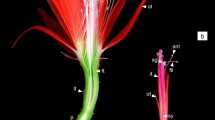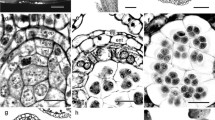Abstract
The petals ofAngophora flowers are compound structures consisting of two morphologically distinct components that develop along separate morphogenetic pathways. These two components are also evident in the corolline parts of the bloodwood eucalypts. In occasional flowers ofAngophora and some bloodwoods, several adjacent corolline primordia may become continuous due to interprimordial growth, but the petals are mostly free at anthesis. In other bloodwood eucalypt species all the primordia in the corolline whorl become continuous at some stage in development, resulting in an operculum that is anatomically unresolvable into its original petaline parts. The varying degrees of this continuity that are evident within individual trees (and even within single flowers) suggests that operculum formation is an epigenetic event that is determined by morphogenetic processes within the flower. It is suggested that these may relate to differing rates of growth in different regions of the bud.
Similar content being viewed by others
References
Bentham, G., 1866: Flora Australiensis 3. — London: Lovell Reeve & Co.
—, 1869: Notes onMyrtaceae. — J. Linn. Soc. Bot.10: 101–166.
Blakely, W. F., 1934: A key to the Eucalypts. 1st ed. — Sydney: The Worker Trustees.
Briggs, B. G., Johnson, L. A. S., 1979: Evolution in theMyrtaceae—evidence from inflorescence structure. — Proc. Linn. Soc. New South Wales102: 157–256.
Brown, R., 1814: General remarks, geographical and systematical, on the botany of Terra Australis. — Appendix toFlinders, M.,: Voyage to Terra Australis3. — London: Lovell Reeve & Co.
Carr, D. J., Carr, S. G. M., 1959: Floral morphology and the taxonomy ofEucalyptus. — Nature184: 1549–1552.
—, —, 1962a: Natural groups within the genusEucalyptus. — InLeeper, G. W., (Ed.): The evolution of living things, pp. 426–445. — Melbourne: University Press.
Carr, S. G. M., Carr, D. J., 1962b: Convergence and progression inEucalyptus andSymphyomyrtus. — Nature196: 967–972.
—, —, 1968: Operculum development and the taxonomy of eucalypts. — Nature219: 513–515.
Fuchs, C., 1963: Fuchsin staining with NaOH clearing for lignified elements for whole plants or plant organs. — Stain Technol.38: 141–144.
Hamilton, C. D., 1952: The operculum of Marri (Eucalyptus calophylla R. Br.). — Austral. Forestry16: 43–45.
L'Héritier de Brutelle, C. L., 1788: Sertum Anglicum, seu plantae rariores quae in hortis juxta Londinum, inprimus in horto Regi Kewensi excoluntur, ab anno 1786 ad annum 1787 observatae. — Paris: P.-F. Didot.
Hooker, J. D., 1860: The botany of the Antarctic voyage part 3. Flora Tasmaniae 1 Dicotyledons. — London: Lovell Reeve.
Humphries, C. J., Funk, V. A., 1984: Cladistic Methodology. — InHeywood, V. H., Moore, D. M., (Eds.): Current topics in plant taxonomy. — Systematics Assoc. Special Volume No.25. — London: Academic Press.
Jacobs, M. R., 1955: Growth habits of the Eucalypts. — Canberra: Government Printer.
Johnson, L. A. S., Briggs, B. G., 1984:Myrtales andMyrtaceae—a phylogenetic analysis. — Ann. Missouri Bot. Gard.71: 700–756.
Ladiges, P. Y., 1984: A comparative study of trichomes inAngophora Cav. andEucalyptus L'Hérit.—a question of homology. — Austral. J. Bot.32: 561–574.
—, 1983: A cladistic study ofArillastrum, Angophora andEucalyptus (Myrtaceae). — J. Linn. Soc. Bot.87: 105–134.
Maiden, J. H., 1923: A critical revision of the genusEucalyptus 6. — Sydney: Government Printer.
Mueller, F. von, 1879–1884: Eucalyptographia. — Melbourne: Government Printer.
Payer, J. B., 1857: Traite d'organographie de la fleur. — Paris: Libraire de Victor Masson.
Platnick, N. I., 1979: Philosophy and the transformation of cladistics. — Syst. Zool.28: 537–546.
Pryor, L. D., 1954: The inheritance of inflorescence characters inEucalyptus. — Proc. Linn. Soc. New South Wales79: 79–89.
—, 1971: A classification of the Eucalypts. — Canberra: Australian National University.
—, 1971: Operculum development and evolution in eucalypts. — Austral. J. Bot.19: 143–172.
Sattler, R., 1978: “Fusion” and “continuity” in floral morphology. — Notes Roy. Bot. Gard. Edinburgh36: 397–405.
Schmid, R., 1972: A resolution of theEugenia-Syzygium controversy (Myrtaceae). — Amer. J. Bot.59: 423–436.
Schoute, J. C., 1913: Beiträge zur Blattstellungslehre 1. Die Theorie. — Recueil Trav. Bot. Neerl.10: 153–325.
Schwabe, W. W., 1984: Phyllotaxis. — InBarlow, P. W., Carr, D. J., (Eds.): Positional controls in plant development, pp. 403–440. — Cambridge: University Press.
Snow, M., Snow, R., 1933: Experiments on phyllotaxis 2. The effect of displacing a primordium. — Philos. Trans., Ser. B.,222: 353–400.
—, —, 1962: A theory of the regulation of phyllotaxis based onLupinus albus. — Philos. Trans., Ser. B.,244: 483–514.
Wardlaw, C. W., 1968: Essays on form in plants. — Manchester: University Press.
Williams, J. B., 1981: On the occurrence and form of petals inEucalyptus species of the red bloodwood group. — Poster Abstract, 13th International Botanical Congress, Sydney.
Willis, J. L., 1951: The anatomy and morphology of the operculum in the genusEucalyptus 1. The occurrence of petals inEucalyptus gummifera. — Proc. Linn. Soc. New South Wales76: 31–35.
Author information
Authors and Affiliations
Rights and permissions
About this article
Cite this article
Drinnan, A.N., Ladiges, P.Y. Perianth development inAngophora and the bloodwood Eucalypts (Myrtaceae). Pl Syst Evol 160, 219–239 (1988). https://doi.org/10.1007/BF00936049
Received:
Issue Date:
DOI: https://doi.org/10.1007/BF00936049




